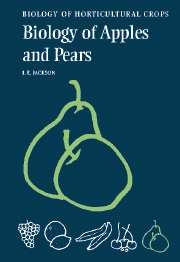Book contents
- Frontmatter
- Contents
- Preface
- Acknowledgements
- Introduction
- 1 The growing of apples and pears
- 2 Apples and pears and their relatives
- 3 Apple and pear root systems: induction, development, structure and function
- 4 The graft union, grafting and budding
- 5 Mechanisms of rootstock and interstock effects on scion vigour
- 6 The shoot system
- 7 Leaves, canopies and light interception
- 8 Photosynthesis, respiration, and carbohydrate transport, partitioning and storage
- 9 Flowers and fruits
- 10 Eating quality and its retention
- 11 Mineral nutrition
- 12 Water relations
- 13 Diseases, pests, and resistance to these
- 14 Biotechnology of apples and pears
- Cultivar Index
- General Index
- References
13 - Diseases, pests, and resistance to these
Published online by Cambridge University Press: 13 August 2009
- Frontmatter
- Contents
- Preface
- Acknowledgements
- Introduction
- 1 The growing of apples and pears
- 2 Apples and pears and their relatives
- 3 Apple and pear root systems: induction, development, structure and function
- 4 The graft union, grafting and budding
- 5 Mechanisms of rootstock and interstock effects on scion vigour
- 6 The shoot system
- 7 Leaves, canopies and light interception
- 8 Photosynthesis, respiration, and carbohydrate transport, partitioning and storage
- 9 Flowers and fruits
- 10 Eating quality and its retention
- 11 Mineral nutrition
- 12 Water relations
- 13 Diseases, pests, and resistance to these
- 14 Biotechnology of apples and pears
- Cultivar Index
- General Index
- References
Summary
Introduction
Apples and pears are subject to a large number of diseases and pests. Some are very obvious and may cause distinctive damage. Others are virtually symptomless other than leading to reduced growth and cropping.
The impact of the different diseases and pests may be reduced by confining susceptible cultivars to regions of climate unsuitable for the pathogen. It may also be reduced by the use of quarantine and ‘plant health’ procedures designed to ensure healthy planting material. Control of damage where conditions are such as to make this a serious threat may be achieved by chemical and biological control agents and by the deliberate breeding of resistant cultivars.
With the world-wide expansion of apple and pear growing, new pest and disease problems have arisen. Consumer fears of pesticide residues and concerns about ecological impacts have placed significant constraints on chemical control. Biological and ‘integrated’ control methods to reduce chemical inputs may require sophisticated localized monitoring of both pathogens and environmental factors. Genetic resistance may break down as new strains of disease organisms and pests evolve. Control of disease and pest incidence is thus very complex. Emphasis in this chapter is given to the pests and diseases of greatest importance in Europe, North America and Australasia and genetic resistance to these. Discussion of chemical and biological control and of specific pests and diseases prevalent in Asia, Africa and South America is more limited.
- Type
- Chapter
- Information
- The Biology of Apples and Pears , pp. 448 - 472Publisher: Cambridge University PressPrint publication year: 2003
References
- 1
- Cited by



